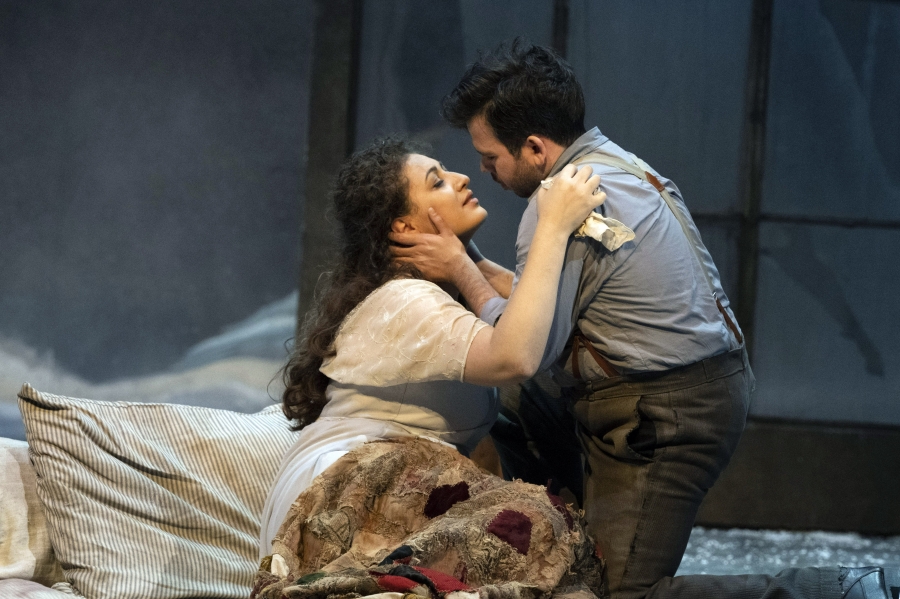The WNO Autumn season continues with a classic, revisiting one of the most famous – and, arguably, most influential – among Puccini’s works. La Bohème is, undeniably, in its own way a flawed opera: light on the plot, abrupt in the character development, it is regardless iconic, and for good reason, in spite of its weaknesses and in part because of them. First of all, there are some of the most instantly recognisable musical moments in Puccini’s work, including the famous aria Che gelida manina, which will be familiar even for those who are not opera connoisseurs. Then there are some characters which are able to immediately speak to the emotions of the audience; narratively weak they might be in place, but they are undoubtedly emotionally strong, and it is hard not to laugh and cry with them, not to root for them, not to hope that they will manage to prevail in their precarious day-to-day life.
Mimì (here played with remarkable vocal precision and softness of delivery by Anush Hovannisyan) is one of the iconic female figures in the history of opera, her stage appearances incisive from her first, flirtatious interaction with the poet Rodolfo (Luis Gomes, who does an excellent job at handling the complexities and contradictions of his character without losing the focus on his delivery of a part which includes a number of recognisable sections) to her tragic death, which provides an abrupt tonal shift to the last act of the production. Her counterparts on stage are no less memorable: the group of penniless artists around whom the action develops is immediately charming and relatable, and familiar in a way to a modern audience that is not unaware of the equally precarious lifestyle which is often the lot of those who choose the arts as a career even today. All cast members are to be applauded in the way in which they convincingly inhabit their characters, imbuing their performances with a liveliness and a credibility that goes a long way towards making them relatable. Rodion Pogossov gives an explosive energy to the painter Marcello, and a special mention must be given to Haegee Lee , who manages to tackle and seamlessly convey all the complexities of the character of Musetta, perhaps the most nuanced and multifaceted of the cast of people at the margins populating this opera.
Anush Hovannisyan and Luis Gomes
Haegee Lee and Rodion Pogossov
It is precisely in this set of characters that both the weakness and the strength of La Bohème reside. Nominally telling the tale of a doomed love story, it is truly meant to be a representation of an entire demographic, an accurate depiction of a lifestyle at the edges, half chosen by, half forced onto those who elect to pursue the arts and who embrace the sense of impermanence that comes with it. As such, it is a work that places enormous focus on the choral aspects, as it is more concerned with presenting a portrait of a group of people than with truly developing the narrative tensions within its main plotline. There is no denying that the latter, when we approach the text, appears rushed in places as a result, and there is a subtle frustration whenever one watches this opera, in feeling that some things would have been better served by being explored in greater depth. And yet at the same time it is precisely this plurality of voices, this collective narration that makes this work so attractive and compelling. This is mirrored, too, by the staging of the WNO production, which is acutely aware of the collective nature of the protagonists of the opera, and which particularly shines in the scenes where a greater number of characters tread the stage, carefully choreographed and bringing to life the lively, raunchy, electric atmospheres of the bohemian Paris.
The production addresses as well the various shifts of tone that mark the transitions within this work. Its plurality of voice is undoubtedly one of its strengths, with an ability to move from cheeky to triumphant, from touching to sombre without the juxtaposition feeling too jarring. Undoubtedly the direction, curated for this revival by Caroline Chaney, is to be praised for this; but, aptly for a work that has the same type of plural focus one might find between the pages of Victor Hugo’s Les Miserables (which is, not by coincidence, also set in Paris during the Bourbon Restoration), the credit for the success of this production can only be split in equal parts among all the cast and creatives who each contributed a piece to a narrative puzzle which hides remarkable complexity behind its apparent simplicity.
Wales Millennium Centre until October 6 then touring until December 3, including Venue Cymru Llandudno, October 12, 13.
Images: Richard Hubert Smith

